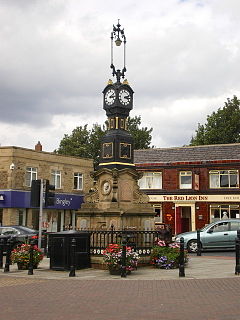Heckmondwike
| Heckmondwike | |
|---|---|
 Clock in Heckmondwike's centre, erected in 1863 to commemorate the marriage of The Prince of Wales and Princess Alexandra of Denmark. |
|
| Heckmondwike shown within West Yorkshire | |
| Population | 16,986 (Ward.2011) |
| OS grid reference | SE216234 |
| Metropolitan borough | |
| Metropolitan county | |
| Region | |
| Country | England |
| Sovereign state | United Kingdom |
| Post town | HECKMONDWIKE |
| Postcode district | WF16 |
| Dialling code | 01924 |
| Police | West Yorkshire |
| Fire | West Yorkshire |
| Ambulance | Yorkshire |
| EU Parliament | Yorkshire and the Humber |
| UK Parliament | |
Heckmondwike is a town and electoral ward in the metropolitan borough of Kirklees, West Yorkshire, England, 9 miles (14 km) south west of Leeds. Historically part of the West Riding of Yorkshire, it is close to Cleckheaton and Liversedge. It is in the Batley and Spen parliamentary constituency, and had an estimated population of 17,066 in March 2001, reducing to 16,986 at the 2011 Census.
The origins of Heckmondwike are in Old English. First recorded as Hedmundewic [sic] in the Domesday Book of 1086, Hedmundewic in 1166, and as Hecmundewik sometime in the 13th century, the name seems to be from *Hēahmundes wīc, or 'Heahmund's dairy-farm'.
During Saxon times Heckmondwike was a "berewick" or independent village in the manor of Gomersal, which, before 1066, was held by Dunstan and Gamel. After the Norman Conquest, William confiscated the land and divided it amongst his followers, one of which, Ilbert de Lacy, was made Baron of Pontefract and over-lord of vast stretches of land, including the Spen Valley.
The Poll Tax of 1379 records there were seven families in Heckmondwike, about 35 people including one named Thomas of Stubly. Most lived in isolated farmsteads such as Stubley Farm, on high ground overlooking the marshy Spen Valley floor.
In 1684 there were around 250 people in the township, occupying 50 houses. The town became famous for manufacturing blankets and by 1811 the Blanket Hall was built for trade in the town's primary manufacture. It was replaced by a second hall erected in 1839, on Blanket Hall Street in the town centre. Elizabeth Gaskell's biography of Charlotte Brontë in 1857 described the inhabitants of Heckmondwike as "a chapel-going people, very critical of their sermons, tyrannical to their ministers and violent radicals".
...
Wikipedia

